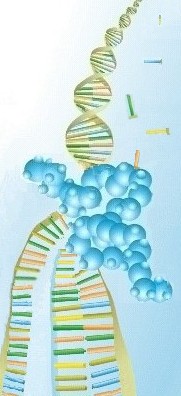
 |
Proteins are the most important building materials of the body. They execute all tasks necessary for life maintenance and the functioning of our body. Several examples: muscles and hair consist of protein materials. Other proteins form miniature tools, called enzymes, in a body cell.
Now scientists want to find out for each protein which function it has in the body and with which other protein materials it must interact to fulfill its task. It takes a complex interaction of proteins for certain traits to appear or processes to occur in the body. For example, there is not only one protein for eye color, but many that help to produce the pigment.
Furthermore, the researchers want to determine where the individual proteins are to be found in the body. To do that, they have to know which blueprints are just now being "read off" in the selected body region. "Reading off" means that the individual building instructions are being copied from the long strand of the DNA. This occurs by means of a copying tool that moves along the corresponding segment of the DNA strand and generates an exact copy of the gene letter sequence. This copy is then utilized at the protein factories as the blueprint for producing a protein.
Every cell of the body, no matter in which tissue it is situated nor which function it has, contains the complete genetic information, i.e. all 25,000 blueprints. And every cell of the body has its own program determining exactly at which time a certain protein should be produced. The blueprint presently being read is called an "active gene" in technical lingo.
With the aid of gene chips genome researchers can now investigate many hundreds of genes (protein blueprints) at the same time and can determine which genes are presently activated in a certain tissue. Other sophisticated techniques make it possible to figure out the function of the proteins.
Thus, bit by bit a "wiring diagram" for the processes in our body is emerging. With the aid of this wiring diagram, genome researchers are able to understand how diseases develop because they are able to compare the wiring diagram of a healthy person with that of a sick patient and find out which components of the patient’s wiring diagram contain errors.
Next chapter:
- Healing - progressing toward the tailor-made therapy: how genome research can help in developing new drugs and increasing the chances of a cure.




